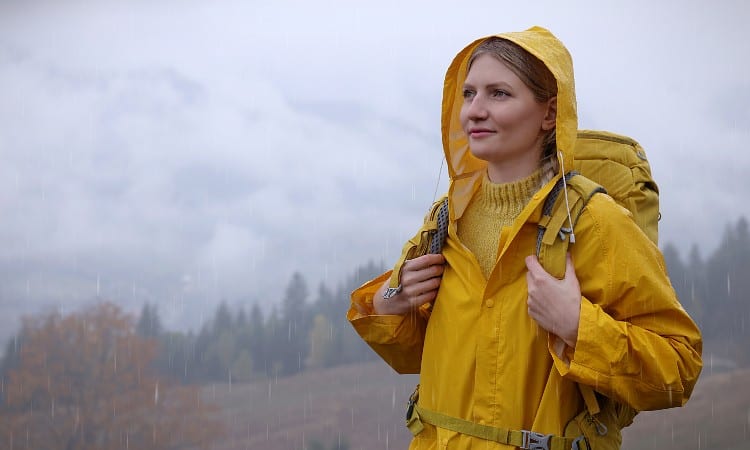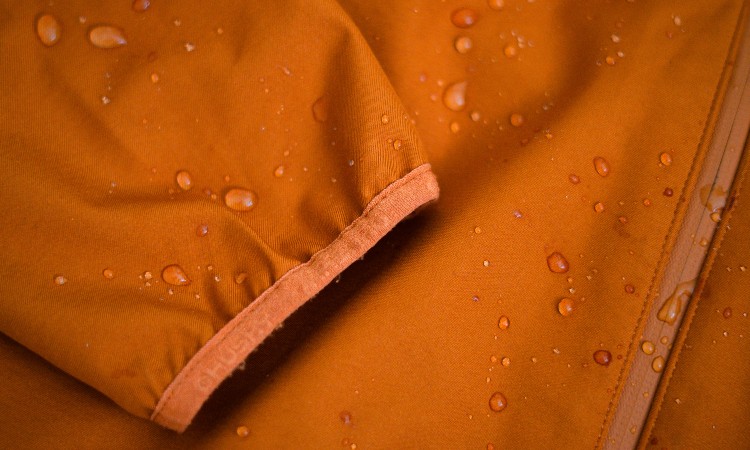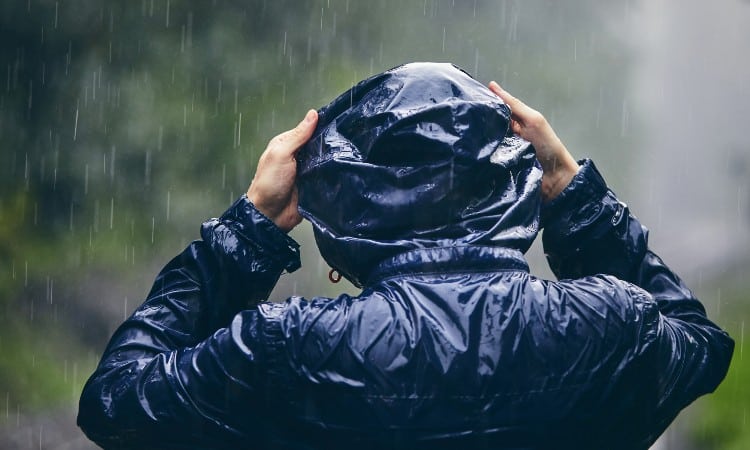There’s nothing worse than getting drenched from a sudden downpour. That’s why it’s always good to have a raincoat handy. We wear raincoats to keep our clothes from getting wet, but we want the raincoat to be as effective as possible. So what’s the best raincoat material to keep you the driest?
The best raincoat materials are:
- PVC (vinyl)
- Neoprene
- Gore-Tex
- Polyurethane (PU)
- Thermoplastic PU
- Microfiber
- Nylon
- Polyester
- Laminated cotton
- Waxed cotton
- Wool
These materials are waterproof, water repellent, or water-resistant and do a great job of keeping you dry.
But is one of these materials the best overall? And what’s the difference between waterproof, water repellent, and water-resistant materials? I’ll explain this, as well as the characteristics and pros and cons of these materials. That way, you can decide what raincoat material is the best for you.

Quick Navigation
What Is a Raincoat Made Of?
I’m sure you know that raincoats aren’t made of the typical fabrics used to make other types of clothing. That means you’ll find very few raincoats made out of cotton, linen, silk, etc., because these materials aren’t very good at keeping you dry when it rains.
Instead, raincoats are made from fabrics and materials that are waterproof, or at the very least, water repellent or water resistant. You’ve probably noticed that many raincoats can even have a plastic-like feel to them.
This is because plastic-like materials don’t absorb water. Instead, the idea is for water to pool on the fabric or run off the coat to keep you dry. If the primary material used to make a raincoat is not waterproof or water-resistant, it will at least have a coating on it that makes it repel water.
What Is the Best Material for a Raincoat?
So what material is best for a raincoat? I don’t know if there is one true best material for a raincoat, but it depends on what you’re looking for in a raincoat, where you live, and your lifestyle. However, several materials are commonly used for raincoats because they are effective at keeping you dry.
Here, we’ll look at the best raincoat materials and the characteristics and pros and cons of each one. I’ll also explain whether these materials are waterproof, water repellent, or water-resistant.
1. PVC (Vinyl)
 PVC fabric (also known as polyvinyl chloride or simply vinyl) is one of the best materials for a raincoat if you want it to be waterproof. PVC fabric is a synthetic plastic fabric with a wide range of applications in addition to using it to make clothing.
PVC fabric (also known as polyvinyl chloride or simply vinyl) is one of the best materials for a raincoat if you want it to be waterproof. PVC fabric is a synthetic plastic fabric with a wide range of applications in addition to using it to make clothing.
When used to make raincoats, PVC is a medium-weight fabric that is very durable and can last for many years. The downside is that PVC fabric is not breathable and can feel stuffy or thick. PVC also isn’t the most stylish material to use for a raincoat if you want something that’s both functional and stylish.
2. Neoprene
 Neoprene is another good waterproof raincoat material. Neoprene is also used for wetsuits, bathing suits, and beach accessories because it keeps the wearer dry. This is another artificial, synthetic material that resembles rubber.
Neoprene is another good waterproof raincoat material. Neoprene is also used for wetsuits, bathing suits, and beach accessories because it keeps the wearer dry. This is another artificial, synthetic material that resembles rubber.
Neoprene is very durable but is also thick and heavy. It’s good for super heavy rains, but some people may not like how thick and heavy it can be while wearing it. It’s also not the most stylish material, serving more of a practical purpose.
3. Gore-Tex
 Gore-Tex is a type of synthetic, technical fiber often used in clothing designed to be worn outdoors. It is waterproof while also being breathable. And not only is it waterproof, but it is also resistant to wind. This is a great choice if you live in a harsher climate where it rains heavily or gets cold often.
Gore-Tex is a type of synthetic, technical fiber often used in clothing designed to be worn outdoors. It is waterproof while also being breathable. And not only is it waterproof, but it is also resistant to wind. This is a great choice if you live in a harsher climate where it rains heavily or gets cold often.
But it may not be a good choice if you live in a warmer climate where it doesn’t rain often. Gore-Tex raincoats also aren’t as widely available and can also be pricey. And like other waterproof fabrics, Gore-Tex raincoats mostly serve a strictly functional purpose.
4. Polyurethane (PU)
 Polyurethane is another type of plastic material that is sometimes abbreviated as PU. The polyurethane base is polyester treated with a coating to make it either water-repellent or waterproof. Polyurethane is very versatile and can be used to make both stylish and functional raincoats, depending on the type of polyurethane used.
Polyurethane is another type of plastic material that is sometimes abbreviated as PU. The polyurethane base is polyester treated with a coating to make it either water-repellent or waterproof. Polyurethane is very versatile and can be used to make both stylish and functional raincoats, depending on the type of polyurethane used.
It tends to be heavier, so some people may not like the heavy feel when worn. But many polyurethane raincoats also have a plastic backing or lining in them. Overall, though, if you want a raincoat that is very strong and durable, polyurethane is a good choice.
5. Microfiber
No products found.Microfiber is a version of polyester fabric that is very versatile. It’s used in upholstery to make furniture more impervious to water damage and stains, but it is also used in raincoats. You can find microfiber raincoats that are more stylish and, in some cases, more high-end than raincoats made from PVC or other more functional fabrics.That doesn’t mean that microfiber isn’t functional. It is just more water-resistant than it is waterproof. It’s also breathable and lightweight than other fabrics. However, some microfiber raincoats may be coated to make them more resistant to water or have a plastic-like lining on the inside if the outside does get saturated. While both of these things increase the level of protection you get, they also lower the breathability of the microfiber.
6. Nylon
 Nylon is another highly functional, multi-purpose fabric. But how effective it is for raincoats depends on whether it is standalone nylon fabric or treated nylon fabric. It makes a difference because nylon fabric is generally water-resistant, but treated nylon is more water-repellent.
Nylon is another highly functional, multi-purpose fabric. But how effective it is for raincoats depends on whether it is standalone nylon fabric or treated nylon fabric. It makes a difference because nylon fabric is generally water-resistant, but treated nylon is more water-repellent.
Nylon is better for lighter rains because it can become saturated if it gets too wet. But treated nylon is better for heavy rains. You can tell the difference because treated nylon tends to be slightly shinier. Either version of nylon is very durable, but both are more functional than stylish.
7. Polyester
 Polyester is similar to nylon in that when used for raincoats, it can be either water-resistant or water repellent, depending on if it is treated or not. But, it will rarely be entirely waterproof. Most affordable raincoats will generally be made out of treated polyester just because a wide variety of polyester fabrics are available.
Polyester is similar to nylon in that when used for raincoats, it can be either water-resistant or water repellent, depending on if it is treated or not. But, it will rarely be entirely waterproof. Most affordable raincoats will generally be made out of treated polyester just because a wide variety of polyester fabrics are available.
That being said, polyester raincoats can be both stylish and functional. You can have plain-colored raincoats or patterned raincoats. However, polyester is generally better for light to medium rains than heavy rains.
8. Laminated Cotton
 Cotton by itself is not a very functional material to use for raincoats. However, due to its affordability and availability, textile manufacturers have found a way to make cotton functional by “laminating” it.
Cotton by itself is not a very functional material to use for raincoats. However, due to its affordability and availability, textile manufacturers have found a way to make cotton functional by “laminating” it.
Laminating means the cotton has been treated with a coating to make it more water repellent. It’s not 100% waterproof, but it’s a good alternative to raincoats made of polyurethane since cotton is more breathable. It’s also an eco-friendlier choice if you prefer natural fabrics, but raincoats made from this material may not be as widely available.
9. Waxed Cotton
 Waxed cotton is another type of cotton fabric that has been treated to make it more water-repellent. As the name implies, waxed cotton has been treated with wax. Unlike laminated cotton, waxed cotton is generally made from canvas, which is a heavier cotton fabric.
Waxed cotton is another type of cotton fabric that has been treated to make it more water-repellent. As the name implies, waxed cotton has been treated with wax. Unlike laminated cotton, waxed cotton is generally made from canvas, which is a heavier cotton fabric.
Waxed cotton is a very heavy-duty and functional fabric for raincoats. In fact, it’s commonly used for outerwear. But it can be too heavy for some people, and it isn’t as popular to use for raincoats as other materials are.
10. Thermoplastic PU
Thermoplastic polyurethane, or thermoplastic PU, is very similar to polyurethane. But the main difference is that raincoats made from thermoplastic PU are designed more with function in mind than with style.
They’re still made with treated polyester, but thermoplastic PU raincoats are designed more for sports and outdoor purposes. Not only are they designed to be water repellent, but also windproof. They’re good for spending a lot of time outdoors during colder and rainier seasons and are similar to Gore-Tex without being quite waterproof.
10. Wool
Last on the list, but certainly not least, is wool. Wool is the best fabric for raincoats if you want something more stylish, as it has a unique texture and is often used for more high-end garments. It’s also a natural fabric if you want to be more eco-conscious with your clothing choices. But wool is not the most waterproof or functional raincoat material.
Instead, wool has a natural water resistance due to the fibers being coated with a waxy substance known as lanolin. It will do a good job of keeping you dry to an extent but can become saturated in heavy rains. It will dry quickly and keep you warm but isn’t the best choice in heavy rains. Some people find wool itchy, and others are even allergic to it.
Waterproof vs. Water Repellent vs. Water Resistant

Now that we’ve looked at all of the best materials for raincoats, what is the difference between waterproof, water repellent, or water-resistant materials? While all of these terms mean that they help keep you dry at some level, they do not all mean the same thing. Let’s look at the differences.
Waterproof
Waterproof fabric is designed to keep you 100% dry. The fabric is supposed to be impervious to water, meaning water can’t penetrate the fabric at all. The fabric has no pores or openings for water to seep through.
If you live somewhere where it rains heavily or spend a lot of time outdoors or on the water, you want a raincoat made of waterproof material. To recap, waterproof raincoat materials include PVC, neoprene, Gore-Tex, and some treated versions of polyester.
Water Repellent
If a fabric is water-repellent, it means that it has been treated with a coating to help repel water. But the fabric itself may not be completely waterproof. The coating enables water to pool up on the fabric and run off of it. That means that water-repellent raincoats will still keep you pretty dry. Just don’t expect them to be completely waterproof.
But with more wear, as the coating starts to wear down, you may find that the water-repellent coating is less effective over time. Water-repellent raincoats are good if you’re only occasionally outdoors in the rain or it doesn’t always rain heavily in your area. Many raincoats that are water repellent are made from a base layer of cotton, nylon, or polyester that has been treated with a special coating.
Water-Resistant
Some raincoat materials are only water-resistant. Water-resistant materials will still keep you somewhat dry, but they are the least effective. They only repel water to an extent, but they are only good for light rains and not heavy ones.
This is because they may become saturated in heavy rains and won’t keep you dry in that case. Nylon and polyester that haven’t been treated are generally water-resistant, as are some types of treated cotton.
Which Raincoat Material Is Best for Heavy Rain?
Now that we’ve looked at all of the best raincoat fabrics and learned the differences in the level of dryness they provide, you may be wondering what material is best for heavy rain. This is a valid question, especially if you live where it does rain heavily.
For heavy rain, you’ll want a fabric that is as close to waterproof as possible. PVC and polyurethane fabrics are good choices, as are Gore-Tex and Neoprene. You might even choose a raincoat material that is water-repellent if it only rains heavily occasionally. But you don’t want a fabric that is only water-resistant because it may become saturated too easily and won’t be as effective.
How to Choose Raincoat Material

Considering everything that we’ve looked at, how do you choose the best raincoat material for you? There are several factors that you need to consider.
Climate
You’ll first want to consider the climate in which you live. Does it often rain, only occasionally, or hardly ever at all? When it does rain, does it tend to rain heavily for long periods, or is it just short, light rain showers?
If you live somewhere with heavy rains, consider a coat made of waterproof or water-repellent material. If it only rains occasionally or lightly, you can get away with a material that is simply water-resistant.
Lifestyle
Next, consider your lifestyle. Do you spend a lot of time outdoors for leisure or work? You may wish to have a raincoat on hand just in case and want something that is more waterproof in the event it rains heavily.
Also, if you live in a city and walk or bike to work, you may want a raincoat for those rainy days. It’s good to consider your lifestyle and the climate in which you live when choosing a raincoat material.
Raincoat Style
Then, consider the style of raincoat that you want. Do you want casual or something more stylish? If you want something casual, there are plenty of good raincoat material options. If you want something stylish, you’ll want to go with polyester, wool, microfiber, or polyurethane. Just make sure that whatever material you choose is functional for your lifestyle as well.
Price
Finally, consider the price of the fabric. Part of the price you’re paying is for the fabric itself, and fabrics such as wool or nylon may be more expensive than polyester or PVC. You’re also paying for the brand name that’s on the raincoat. Designer or luxury raincoats will cost more and may be made of higher quality materials.
Conclusion
As you can see, there isn’t any one best raincoat material. Rather, the best material depends on your climate, lifestyle, and style preferences. Some materials may be waterproof, water repellent, or water-resistant, so you need to decide which one works best for your needs. Hopefully, this article helped to make your decision easier. If you did find it helpful, be sure to share it with others.